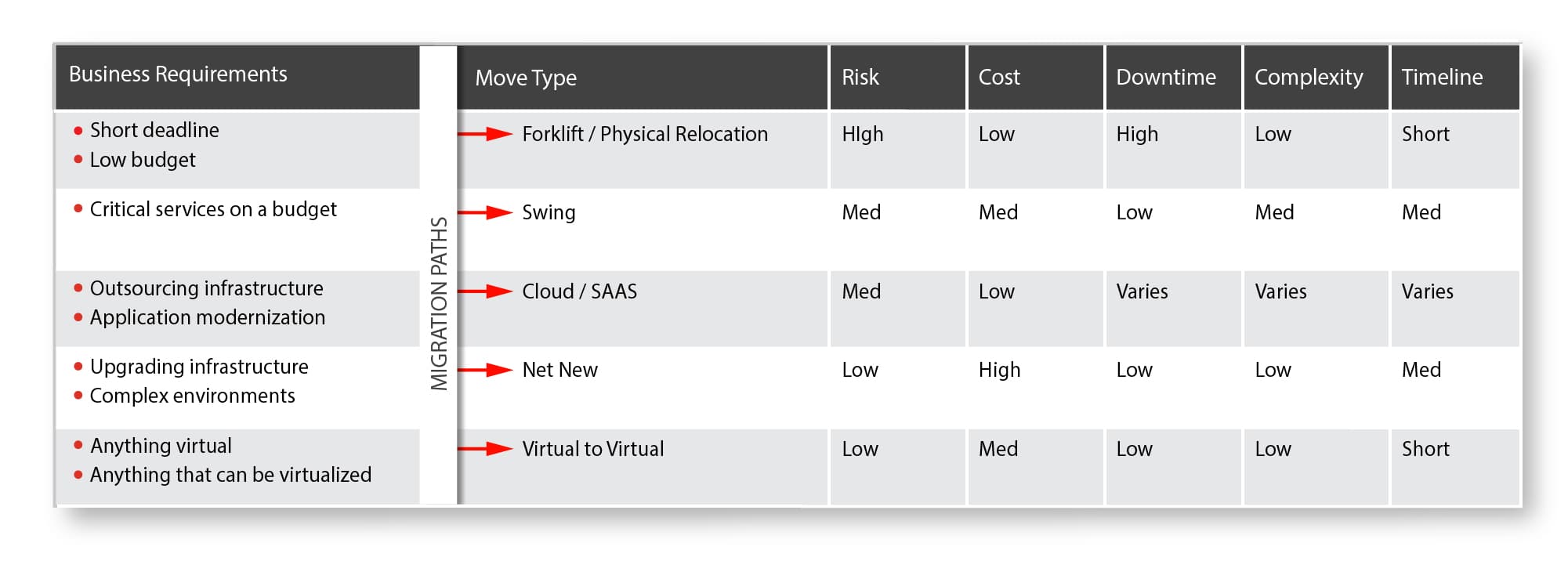The Expanding Boundaries of the Data Center
Today’s business environment is full of shifting boundaries. The interconnectivity of people, businesses, and “intelligent things” is blurring the boundaries between business operations and IT operations.
IT now functions as a proactive driver in delivering strategic business initiatives and not just a gate keeper for data center operations. As boundaries expand at what can feel like break-neck speed, the data center is emerging as a borderless profit center — not just a cost center surrounded by four physical walls.
Many organizations are wrestling with how to compete in this brave new business world. Most executives understand the need for agility in their data centers, but many struggle with the challenges of
- Where do we start?
- How do our data centers meet our business agility needs?
- What are the risks and how do we manage them?
- How much and how long?
Developing an IT Modernization and Optimization Strategy
Your business strategy must drive your IT modernization and optimization strategy. Some would say they are one and the same.
David-Kenneth Group recommends a master IT modernization and optimization roadmap. It should include application and workload placement options and a digital infrastructure capable of supporting those decisions, i.e., on/off premise cloud, edge computing, hyper converged, colocation and/or owned and operated data centers.
The strategy must deliver on today’s business needs and be capable of responding to future digital demands, including exit strategies that support dynamic relocation of workloads.
- Assess and Align
- Delivery Roadmap
- Migration Planning
- Network Planning
- Cost Estimation
- Disaster Recovery
Each workshop brings together a multidisciplinary team of experts that includes senior leadership, key business stakeholders (lines of business) and technology experts. It is a collaborative process that generates consensus among a diverse set of stakeholders that produces results.
After each workshop, we deliver a report detailing the findings, conclusions, and our recommendations for next steps.
Strategic Planning Workshops
1. Assess and Align
The key in this workshop is to understand the business needs. The conversation should end and begin there. Assess how the business goals and the delivery of IT services are aligned. Take stock in the current state of affairs: what is being done well, how can improvements be made, where are the gaps, and how do we use technology to innovate?
In this workshop we also discuss the organizational roadblocks that impede progress and what steps will affect the greatest positive impact for the business. We document those steps into near-term, mid-term, and long-term goals and identify how the IT goals support the business goals.
2. Delivery Roadmap
IT operations need to deliver responsive services faster across the entire organization. The greater the speed and the ability to scale, the greater the market impact and business value (See Figure 1).
How do we meet the business need? Getting there is unique to every organization, and it looks different for every organization. It can include a combination of on-premise and off-premise cloud, data centers (geographically dispersed), colo-providers, hyper converged infrastructure, edge computing or traditional IT infrastructure.
The answer for your organization is dependent on a number of factors: your timeline, budget, organizational culture, current state, and your business’s need for digital agility.
Having a roadmap enables your organization to visualize what is needed tactically and strategically. David-Kenneth Group works with you to craft an achievable plan that moves the needle forward at a tempo that makes sense for your organization.
3. Migration Planning
Migration planning creates a transition plan and a high-to-medium level timeline that moves you towards IT modernization and optimization. We determine the best way to migrate your workloads, manage risks, and modernize your IT infrastructure, while controlling and managing costs and providing strategies for procurement and vendor negotiations.
4. Network Planning
While new modes of network delivery for an enterprise can deliver speed and scale, it can only deliver on expectations if it has a network optimized to flow seamlessly and rapidly adapt to business changes.
The network planning workshop evaluates workload placement and application rationalization to ensure the network does not become a bottleneck. This workshop produces a network topology that lists the viable connectivity options, potential carriers, network design elements, as well as redundancies. We’ll also consider the overhead needed to support operations.
5. Cost Estimation
The cost estimation workshop produces budget estimates based on details in the roadmap and the migration and network planning workshops. This effort produces three cost estimates for:
- Staffing
- Delivery
- Infrastructure
6. Disaster Recovery
The disaster recovery (DR) workshop develops an initial DR strategy based on the roadmap. Our subject matter experts will leverage your current program whenever applicable to capitalize on cost savings and recommend a plan for closing the gaps or rightsizing based on your changing IT landscape.
The digital economy is here to stay. Organizations that can deliver new services faster and more efficiently will tip the competitive scale to their advantage, even if the ground beneath their feet is shifting.


